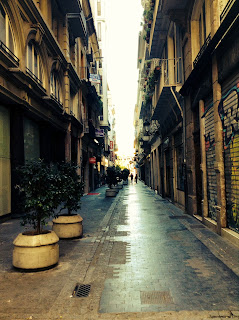I think one of the main things I like about Valencia is how colorful it can be. The juxtaposition between the long dusty roads and dried pebbled paths fringed by sudden plush green grass and trees. The orange trees and fountains, the typically bright painted houses, the colors of the food!
The left-hand photo shows a typical little Valencian street, the photo on the right shows the tucked away little bakeries and shops that pop out at you from these little streets so unexpectedly!
On my wanders I cam across this street in Russafa, and the bright colors and little balconies made instantly my favorite in Valencia.
At the city centre one comes across all the plazas, winding streets and churches that make Valencia so beautiful. Even though the old center isn't very large, it is definitely worth wandering through.
Plaza De la Virgin can be seen behind me in the photo on the left - during the Fallas a giant effigy of the Virgin Mary is built here, and then covered in real flowers. The fountain represents the River Turia. On the right is Valencia Nord, the very pretty lemon-colored train station.


A closer photo of the Plaza. The Cathedral of Santa Maria, Valencia's most important church dominates the plaza, which has been used since Roman times. In the background you can see the El Miguelete (The tower off to the right) which was built in the 14th and 15th C and is 63 meters tall.
The view of the Church and important governmental building from the other side. The yellow cordoned off railing area on the courtyard may not look interesting, but in fact look down into the foundations of the old Roman Baths that once stood here. Unfortunately due to it being winter and I suppose not tourist season, they were covered up for maintenance work.
Another of my favourite historical structures is this, the Torres de Serranos. This fortified gatehouse is all that remains of the once impressive wall that protected Valencia city. Built in the 14th C, this is the largest Gothic city gateway in all of Europe. The beautiful rooms within this structure were used as everything from important meeting rooms to meet foreign dignitaries, to prison cells to the nobility of Valencia.
Climbing up the gatehouse (free on a sunday!) was a hot and tiring job, the sun was beating down and the stairs were never-ending, but it was worth it for the beautiful stone moulding and carvings.
Some randomly interesting things in Valencia. The typical provincial Spanish restaurant on the left (I won't lie, the meat smells like cat-food and doesn't appeal to me) and on the right, the inside of the Cathedral, sunlight streams in and it's not too difficult to believe that the cup that holds pride of place here is indeed the Holy Grail it is professed to be.
At the end of Calle Colon, the central shopping street of Valencia, lies the train station of Valencia Nord, and next to it, Plaza de Toros. The Bull-fighting ring. Designed in 1850, it's not the most attractive building, but it's interesting, and an integral part of Valencian - and Spanish - history.
Colon Market was constructed in 1916 and due to its modernist architecture has been declared a National Monument. I personally thought it was rather stunning, and enjoyed the many little cafes and shops tucked away within it.
It was here that Hot Chocolate was redefined for me -not a milk that tasted chocolatey as I had had all my life, but rather a thick liquid chocolate with a hint of milk flavor to it. Not the straight chocolate you dip churros (deep fried pastry covered in sugar and sometimes cinnamon) into (which is nice for dipping but a bit of a death by chocolate to drink in my opinion) but just a simply amazing Hot Chocolate. All others are ruined for me now. Did I mention there were waffles involved too?
It was here that Hot Chocolate was redefined for me -not a milk that tasted chocolatey as I had had all my life, but rather a thick liquid chocolate with a hint of milk flavor to it. Not the straight chocolate you dip churros (deep fried pastry covered in sugar and sometimes cinnamon) into (which is nice for dipping but a bit of a death by chocolate to drink in my opinion) but just a simply amazing Hot Chocolate. All others are ruined for me now. Did I mention there were waffles involved too?
I came across this street art in my wanderings of the little alleys in the Old City. The doors were in fact real, half-rotten and very old wooden doors. The bicycle and the scene behind the doors were painted on. It's difficult to tell where the physical parts and the painting parts end and begin, which I thought was really beautiful, and so typically random of Spain to simply stumble across.















No comments:
Post a Comment